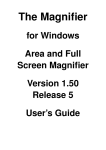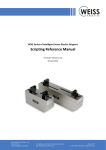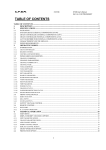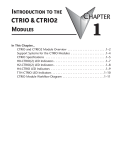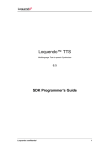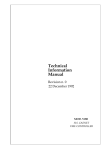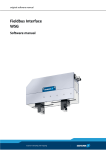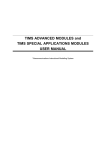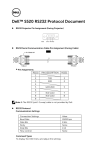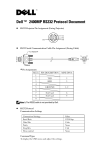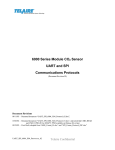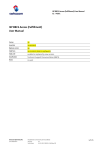Download WSG Command Set Reference
Transcript
Command Set Reference Manual WSG Superior Clamping and Gripping Imprint Imprint Copyright: This manual remains the copyrighted property of SCHUNK GmbH & Co. KG. It is solely supplied to our customers and operators of our products and forms part of the product. This documentation may not be duplicated or made accessible to third parties, in particular competitive companies, without our prior permission. Technical changes: We reserve the right to make alterations for the purpose of technical improvement. Document number: 0389730 Edition: 01.00 |18/08/2015|en © SCHUNK GmbH & Co. KG All rights reserved. Dear customer, congratulations on choosing a SCHUNK product. By choosing SCHUNK, you have opted for the highest precision, top quality and best service. You are going to increase the process reliability of your production and achieve best machining results – to the customer's complete satisfaction. SCHUNK products are inspiring. Our detailed assembly and operation manual will support you. Do you have further questions? You may contact us at any time – even after purchase. Kindest Regards Yours SCHUNK GmbH & Co. KG Spann- und Greiftechnik Bahnhofstr. 106 – 134 D-74348 Lauffen/Neckar Tel. +49-7133-103-0 Fax +49-7133-103-2399 [email protected] www.schunk.com 2 01.00|WSG |en Table of contents Table of contents 1 Introduction ............................................................................................................. 5 1.1 Connecting to the WSG Grippers ............................................................................. 6 1.2 Communicating with the WSG Grippers .................................................................. 6 1.2.1 Command Message Format .......................................................................... 6 1.2.2 Command Acknowledge from the Device .................................................... 8 1.3 Asynchronous Commands ........................................................................................ 9 1.4 Interface Options ...................................................................................................... 9 1.4.1 Disable CRC Checksum .................................................................................. 9 1.4.2 Disable Error State in the event of unheralded ending on TCP Disconnect.... 10 2 WSG Commander .................................................................................................... 11 3 Command Set Reference ......................................................................................... 13 3.1 Connection Management ....................................................................................... 13 3.1.1 Loop (06h) ................................................................................................... 13 3.1.2 Disconnect Announcement (07h) ............................................................... 14 3.2 Motion Control ....................................................................................................... 15 3.2.1 Homing (20h)............................................................................................... 15 3.2.2 Pre-position Fingers (21h) ........................................................................... 16 3.2.3 Stop (22h) .................................................................................................... 19 3.2.4 Issue FAST STOP (23h) ................................................................................. 20 3.2.5 Acknowledging a FAST STOP or Fault Condition (24h) ............................... 20 3.2.6 Grip Part (25h) ............................................................................................. 21 3.2.7 Release Part (26h) ....................................................................................... 23 3.3 Motion Configuration ............................................................................................. 24 3.3.1 Set Acceleration (30h) ................................................................................. 24 3.3.2 Get Acceleration (31h) ................................................................................ 25 3.3.3 Set Force Limit (32h) ................................................................................... 25 3.3.4 Get Force Limit (33h) .................................................................................. 26 3.3.5 Set Soft Limits (34h) .................................................................................... 27 3.3.6 Get Soft Limits (35h) ................................................................................... 28 3.3.7 Clear Soft Limits (36h) ................................................................................. 29 3.3.8 Overdrive Mode (37h)................................................................................. 29 3.3.9 Tare Force Sensor (38h) .............................................................................. 30 3.4 System State Commands ........................................................................................ 31 3.4.1 Get System State (40h) ............................................................................... 31 3.4.2 Get Gripper State (41h) ............................................................................... 33 3.4.3 Get Gripping Statistics (42h) ....................................................................... 35 01.00|WSG |en 3 Table of contents 3.4.4 Get Opening Width (43h) ............................................................................ 36 3.4.5 Get Speed (44h) .......................................................................................... 37 3.4.6 Get Force (45h) ........................................................................................... 39 3.4.7 Get Temperature (46h) ............................................................................... 40 3.5 System Configuration ............................................................................................. 41 3.5.1 Get System Information (50h) .................................................................... 41 3.5.2 Set Device Tag (51h) .................................................................................... 42 3.5.3 Get Device Tag (52h) ................................................................................... 42 3.5.4 Get System Limits (53h) .............................................................................. 43 3.6 Finger Interface ...................................................................................................... 44 3.6.1 Get Finger 1 Info (60h) ................................................................................ 44 3.6.2 Get Finger 1 Flags (61h) .............................................................................. 45 3.6.3 Finger 1 Power Control (62h) ...................................................................... 46 3.6.4 Get Finger 1 Data (63h) ............................................................................... 47 3.6.5 Get Finger 2 Info (70h) ................................................................................ 48 3.6.6 Get Finger 2 Flags (71h) .............................................................................. 49 3.6.7 Finger 2 Power Control (72h) ...................................................................... 50 3.6.8 Get Finger 2 Data (73h) ............................................................................... 51 4 Appendix A: Status Codes ........................................................................................ 52 5 Appendix B: System State Flags ............................................................................... 53 6 Appendix C: Gripper States ...................................................................................... 56 7 Appendix D: Sample code to calculate the checksum ............................................... 57 4 01.00|WSG |en Introduction 1 Introduction The WSG family of grippers can be controlled by different standard interfaces using a binary protocol. This manual gives a detailed explanation of the protocol as well as of the WSG’s command set. To get started with the communication protocol, we recommend the free WSG Commander application running on Microsoft Windows. NOTE The following assumptions are made throughout the manual unless otherwise noted: • Hexadecimal values are noted with a trailing “h”, e.g. 12h, while decimal values are not specially marked. • The data transmission is based on a little endian representation of multi-byte words, where the least significant byte is transferred first. This means that the integer number 1234h is represented by two consecutive bytes 34h and 12h. • Floating point values are represented by 4 byte single precision floating point numbers according to IEEE 754 using the following standard encoding: D31: sign D30…23: exponent D22…0: mantissa • Any set of values is indexed starting with 0, i.e. an array with n elements has an index range of 0…n-1. NOTE The following data types are used by the command set: • integer: Integer number of either 8, 16 or 32 Bit length • float: 32 Bit floating point number according to IEEE 754 • string: An ASCII text that must not contain any control characters • bit vector: usually flags, where every bit has its special meaning • enum: Enumeration. Similar to integer, but every value has a special meaning. 01.00|WSG |en 5 Introduction 1.1 Connecting to the WSG Grippers The WSG family of grippers offers a number of interfaces, each of which uses the same binary mes-sage protocol as described in this manual. Available interfaces are RS-232 serial connection, Ethernet TCP/IP, Ethernet UDP/IP and CAN-Bus, depending on the type. The Fieldbus interfaces for Profibus Profinet and Modbus/TCP interface is fundamentally different from these interfaces. It is covered separately in the “WSG Fieldbus Interface” Manual. The interface configuration can be changed using the WSG’s web interface. Connect the WSG to the local network or directly to your computer’s network interface. Further information contains the assembly and operating manual of the gripping module. Point your favorite web browser to the gripper’s IP address, e.g. by typing the default http://192.168.1.20 into the address bar and pressing “Enter”. After the page has loaded, choose “Settings -> Command Interface” from the menu to configure the standard interface. 1.2 Communicating with the WSG Grippers Regardless of the interface being used, the WSG communicates with its client using binary data packets (exception: Fieldbus interfaces, see manual "WSG Fieldbus interface"). The following chapters describe the general format of these commands. 1.2.1 Command Message Format The table below illustrates the generic command format. All packets start with a preamble signaling the beginning of a new data packet. An identification code describes the content of the packet. It is used as command ID and distinguishes the several commands of the device. The two-byte size value determines the size of the packet’s payload in bytes. A two-byte CRC checksum is added to each packet to verify data integrity. NOTE A source code example for calculating the CRC checksum over a message is given in Appendix D. If the calculation of the checksum causes problems or if you decide not to use the CRC for other reasons, you can disable the WSG’s checksum evaluation using the WSG’s web interface ( 1.4.1, Page 9). 6 01.00|WSG |en Introduction To check a received message, you have to calculate the CRC checksum again over the received data frame including preamble and received checksum. If the received data is correct, the calculated checksum is 0. NOTE For your first steps, we recommend to use the Custom Command Editor function of the WSG Commander tool ( 2, Page 11) to interactively assemble valid data packets with simultaneous display of the transmitted byte sequence. Byte Symbol Description 0..2 PREAMBLE Signals the begin of a new message and has to be AAAAAAh 3 COMMAND_ID ID byte of the command. 4..5 SIZE Size of the packet’s payload in bytes. May be 0 for signaling packets. 6..n PAYLOAD Payload data n+1..n+2 CHECKSUM CRC checksum of the whole data packet, including the preamble. See Appendix D on how to calculate the checksum. NOTICE! If the checksum calculation is disabled, the checksum of the gripping module will not be evaluated and the value of the checksum may be selected as required. However, a checksum must always be included. Messages with missing checksum are rejected by the gripping module as invalid, ( 1.4.1, Page 9). Table 1: Communication packet structure Example 1: Packet with ID = 1, no payload: AAh AAh AAh 01h 00h 00h E8h 10h Example 2: Packet with ID = 1, two bytes payload (12h, 34h), checksum is 666Dh: AAh AAh AAh 01h 02h 00h 12h 34h 6Dh 66h 01.00|WSG |en 7 Introduction 1.2.2 Command Acknowledge from the Device Every command, that was received by the gripping module, is acknowledged by the WSG using a standardized acknowledge packet or returns possible return parameters according to the following format: Byte Symbol Description 0..2 PREAMBLE Signals the begin of a new message and has to be AAAAAAh 3 COMMAND_ID ID of the command. 4..5 SIZE 6..7 STATUS_CODE Status code ( 4, Page 52) 8..n PARAMS n+1..n+2 CHECKSUM Size of the packet’s payload in bytes. This is n – 4, e. g. 2 for a packet with an error code other than E_SUCCESS or 6 for a packet returning E_SUCCESS and a 4-byte command-specific parameter. Command specific parameters. Only available, if the status code is E_SUCCESS. CRC checksum of the whole data packet, including the preamble. See Appendix D on how to check this checksum, ( 7, Page 57). NOTICE! Even if checksum evaluation is disabled, the WSG will always send a valid checksum with its response. The client is responsible for the evaluation (e.g. system control), ( 1.4.1, Page 9). NOTICE! When computing the CRC checksum over the whole data including this checksum field, the result has to be 0. Example 1: Acknowledging a successfully executed command without any return parameters (here: “Homing”-Command): AAh AAh AAh 20h 02h 00h 00h 00h B3h FDh Example 2: Acknowledging an erroneous command (here, Command ID 0x90 is unknown, so the device returns an E_CMD_UNKNOWN, error code 000Eh, error with this ID): AAh AAh AAh 90h 02h 00h 0Eh 00h FDh 02h Example 3: Acknowledging a successfully executed “Get Acceleration”-Command, returning a 4-byte floating point parameter (here: 150.0 mm/s², in hex: 00h 00h 16h 43h): AAh AAh AAh 30h 06h 00h 00h 00h 00h 00h 16h 43h DCh CBh 8 01.00|WSG |en Introduction 1.3 Asynchronous Commands In case the command result is not available immediately, e.g. on movement or referencing com-mands, the WSG returns a notification that it did understand the received command and started its execution (command pending). However, the result will be sent in an additional packet after the command execution has completed. The immediate response to such an asynchronous command will be a packet with E_CMD_PENDING as status code, followed by the additional packet returning the command’s result: Example: Acknowledging the reception of a pre-positioning command (21h, ( 3.2.2, Page 16)) with status code E_CMD_PENDING (001Ah): AAh AAh AAh 21h 02h 00h 1Ah 00h 67h CBh After the target position was reached, the WSG sends the result with an additional packet (here E_SUCCESS, error code 0000h): AAh AAh AAh 21h 02h 00h 00h 00h 28h 04h 1.4 Interface Options Dependent on the interface type, there are some additional settings beyond the basic interface configuration that influence the WSG’s behavior. The following section gives a short overview. 1.4.1 Disable CRC Checksum NOTE This feature is intended for experts only. It is strongly recommended to leave the CRC checksum enabled to ensure maximum data integrity! As described in the previous chapters, a CRC checksum is appended to each message to ensure data integrity when exchanging messages using the WSG’s communication protocol. In some cases, however, it may become necessary to turn off the WSG’s checksum evaluation, e.g. for testing purposes when implementing your own version of the WSG binary protocol or even permanently, if the superior control does not allow a calculation of the checksum and/or the integrity of the data is guaranteed via the subjacent transmission protocol of the selected interface (e.g. for application of TCP network connections). This can be done using the web interface, by choosing “Settings -> Command Interface” from the menu and disabling the appropriate checkbox. If CRC checksum evaluation is disabled, the WSG will ignore the value of the 01.00|WSG |en 9 Introduction checksum field in all messages it receives, though the two-byte checksum field must still be present in all messages. They can take any desired values though. Please note that the checksum evaluation will only be disabled for incoming messages. The WSG’s outgoing messages will always be equipped with a valid checksum, regardless of this option being enabled or not. It is at the discretion of the operator, whether and to what extend the evaluation of the checksum in a superior system control is possible or necessary. It is recommended to activate the evaluation of the checksum for received messages on the gripping module (default setting) as well as to implement it on the superior system control. 1.4.2 Disable Error State in the event of unheralded ending on TCP Disconnect On connection oriented protocols like TCP, accidentally lost connections must be considered as severe errors. This is why the WSG automatically issues a FAST STOP whenever a TCP connection to the command interface is closed by the client without a previous announcement ( 3.1.2, Page 14). Sometimes it may become necessary to turn off this feature. This can be done using the web interface, by choosing “Settings -> Command Interface” from the menu. If TCP is selected as default interface, the appropriate checkbox can be disabled. NOTE This feature is intended for experts only. Lost connections can be a serious problem, so the WSG should always perform a FAST STOP in this case. Try to adjust your application before disabling this error condition. 10 01.00|WSG |en WSG Commander 2 WSG Commander NOTE The WSG Commander is provided as a tool to make the evaluation of the WSG’s command set as easy and comfortable as possible. It comes with no warranty and is not intended to be used in any production environment! The tool WSG Commander is provided free of charge and allows you to get familiar with the WSG’s communication protocol and command set. It allows to send basic commands to the WSG and contains a custom command editor to assemble your own data packets. The data traffic to and from the WSG is displayed, so the communication can be understood easily. The software is running on Microsoft Windows® and can be installed from either the Product CD that ships together with the WSG or can be downloaded at the WSG’s web interface by choosing “Help -> Documentation” from the menu. Main Window To connect to your WSG, select Gripper | Connect from the main menu and select the communication interface. Depending on the interface, additional settings may be necessary. Please note that the gripper has to be configured to use the selected interface via its web interface. Currently, the following interfaces are supported: RS232, CAN-Bus via ESD-Cards as well as Ethernet TCP/IP and UDP/IP. 01.00|WSG |en 11 WSG Commander Custom Command Besides the predefined commands on the main window, you can Editor compose your own commands using the Custom Command Entry dialog and send them to the WSG. To open this dialog, select Commands|Command Editor… from the main menu. You can either choose from predefined IDs or enter your own values here. The payload can consist of bytes in either decimal or hexadecimal (starting with „0x“, e.g. 0x20) format. Also the individual data bytes for the reference data may be entered in the text field "Payload", either as decimal or hexadecimal value. Also floating point values (followed by a „f“, e.g. 150.0f) or text strings (entered in quotation marks, e.g. ”text”) may be entered. The entered data are converted into the byte sequence highlighted in blue ("Command Packet Decoding"), whereby the suitable CRC checksum is generated automatically. By clicking on the Send-Button, it is transferred to the gripper. WSG Commander Custom Command Editor (left) and Communication Log (right) Communication Log To follow the communication between the WSG Commander and the gripper, you may use the Communication Log Panel. It can be accessed using the main menu’s View|Command log entry. You can select the log panel to decode IDs and error codes automatically. If you select one or more bytes inside the log, a popup-menu is displayed and you can convert the selected bytes into their integer or floating point representation as well as decode them as a text string. 12 01.00|WSG |en Command Set Reference 3 Command Set Reference The following chapter describes the command set of the WSG in detail. 3.1 Connection Management 3.1.1 Loop (06h) Loop-back command, which returns the received parameters. This command is intended to be used to test the communication interface. Command ID: 06h Command Parameters: Byte Symbol 0 Data Type LOOPDATA integer Description Payload data to be looped A maximum of 256 bytes of payload data can be looped. Returned Parameters: The received LOOPDATA is identically returned within the command acknowledge (note, that the two bytes error code is automatically added to the beginning of the message as described in ( 1.2.2, Page 8). Possible Status Codes: E_CMD_FORMAT_ERROR: Command length mismatch (more than 256 bytes of payload). E_INVALID_PARAMETER: Parameter value undefined. E_CMD_PENDING: No Error, command is pending. 01.00|WSG |en 13 Command Set Reference 3.1.2 Disconnect Announcement (07h) Announce the disconnection of the current interface. This command is only available with Ethernet TCP/IP connections and can be used to notify the device about a regular disconnection. Any finger movement that is executed when the disconnect announcement arrives is aborted immediately. By sending this command before closing the connection, the gripper will not enter FAST STOP on disconnect. NOTE When issuing a disconnect announcement, the gripper will wait for disconnection. Commands arriving after a disconnect announcement will not be accepted anymore and return an E_ACCESS_DENIED error. New commands may be sent only after regular disconnection and reconnection of the connection. Command ID: 07h Command Parameters: No parameters. Returned Parameters:No parameters are returned. Possible Status Codes: E_SUCCESS: Command succeeded. E_NO_PARAM_EXPECTED: The command does not accept any parameter, but at least one was given. E_NOT_AVAILABLE: Command was used with a nonconnection oriented interface 14 01.00|WSG |en Command Set Reference 3.2 Motion Control 3.2.1 Homing (20h) Execute a homing sequence to reference the gripper fingers. This command has to be executed prior to any other motion-related command. The direction of homing (external or internal referencing) can be either explicitly specified or can be obtained from the gripper’s configuration. During homing, the gripper moves its fingers into the specified direction until it reaches its mechanical end stop. The blocking position is used as new origin for all motionrelated commands. NOTE The best positioning performance will be achieved if homing is done into the direction in which is to be gripped later. NOTE During homing soft limits are ignored! NOTE Obstacles in the movement range of the fingers and collision with these during homing may result in a wrong reference point for the finger position! Command ID: 20h Command Parameters: Byte Symbol 0 Data Type DIRECTION enum Description Homing direction 0: use default value from system configuration (the default value can be changed via the web interface) 1: Homing in positive movement direction 2: Homing in negative movement direction 01.00|WSG |en 15 Command Set Reference Returned Parameters: No parameters are returned Possible Status Codes: Immediate errors: E_ACCESS_DENIED: Gripper is in FAST STOP state. E_ALREADY_RUNNING: Gripper is currently moving. Issue a STOP command, first. E_CMD_FORMAT_ERROR: Command length mismatch. E_INVALID_PARAMETER: Invalid parameter value. E_CMD_PENDING: No Error, command is pending. Errors upon completion of the command: E_SUCCESS: Command succeeded. E_CMD_ABORTED: Homing sequence aborted. E_AXIS_BLOCKED: Axis was blocked while moving away from the end stop. E_TIMEOUT: Timeout while homing 3.2.2 Pre-position Fingers (21h) Move the gripper fingers to a defined opening width. This command is intended to pre-position the gripper fingers prior to a grasp. For grasping or releasing a part in contrast, the commands GRIP_PART ( 3.2.6, Page 21) and RELEASE_PART ( 3.2.7, Page 23) have to be used. You can select between absolute movement, where the fingers are positioned to the given value and a relative movement, where the finger’s opening width is changed relative to their current position. This command is executed asynchronously. After the command has been received, the WSG returns a packet with an E_CMD_PENDING error, meaning it did understand and initiated execution of the command. After the target position was reached or the movement command was interrupted by an error (eg. blocked axis), another message is returned, which returns E_SUCCESS or another status code, which is suitable to the occurred error ( 1.3, Page 9). Speed and position values that are outside the gripper’s physical limits are clamped to the highest/ lowest available value. This includes not only the absolute end values, but possibly also values within the limits that can not be achieved with the current default settings (eg. because acceleration was set too low). It is a good practice to get the gripper’s limits ( 3.5.4, Page 43) and check your motion parameters against it before issuing a motion-related command to ensure that the gripper behaves as intended. 16 01.00|WSG |en Command Set Reference NOTE To get in-depth information about the current finger movement, you may use this command in conjunction with the Get Opening Width command, ( 3.4.4, Page 36) NOTE Pre-positioning always estimates the contact force by measuring the motor current (Force Approximation Mode), regardless of any Force Measurement Fingers that might have been installed. NOTE To grasp or release a part, please use the GRIP_PART command ( 3.2.6, Page 21) or RELEASE_PART command ( 3.2.7, Page 23). NOTE The gripper has to be referenced and may not be in FAST STOP state to start a movement! Command ID: 21h Command Parameters: 01.00|WSG |en 17 Command Set Reference Byte Symbol Data Type Description 0 FLAGS bit vector D7..D2: unused, set to 0 D1: Stop on Block 1: Stop on block. If a blocking condition towards the movement direction of the fingers is detected, the motion command returns an E_AXIS_BLOCKED error and the motor is stopped. 0: Clamp on block. If a blocking condition towards the movement direction of the fingers is detected, the motion command returns an E_AXIS_BLOCKED error. The motor is not turned off automatically, instead there is an attempt to reach the end position with limited force (50% of the nominal gripping force). NOTICE! If the blocking condition is removed while clamping (e.g. the part between the fingers is being removed), the fingers will snap to the target position. D0: Movement Type 1: relative motion The passed width is treated as an offset to the current opening width. 0: absolute motion The passed width is absolute to the closed fingers (0 mm). 1..4 WIDTH float Opening width in mm 5..8 SPEED float Traveling speed in mm/s Returned Parameters: No parameters are returned Possible Status Codes: Immediate errors: E_ACCESS_DENIED: Gripper is in FAST STOP state. E_NOT_INITIALIZED: Gripper is not referenced. Issue a Homing command, first. E_ALREADY_RUNNING: Gripper is currently moving. Issue a STOP command, first. 18 01.00|WSG |en Command Set Reference E_RANGE_ERROR: Soft limits are enabled and the given position falls into these limits. E_CMD_FORMAT_ERROR: Command length mismatch (e.g. length of the message) E_CMD_PENDING: No Error, command is pending. Errors upon completion of the command: E_SUCCESS: Command succeeded. E_INSUFFICIENT_RESOURCES: Out of memory E_AXIS_BLOCKED: Axis is blocked. E_RANGE_ERROR: A limit (either soft or hard limit) was reached during movement. Gripper is stopped. E_TIMEOUT: Timeout while moving E_CMD_ABORTED: The movement command was aborted, e.g. by a Stop command 3.2.3 Stop (22h) Immediately stops any ongoing finger movement. The command sets the SF_AXIS_STOPPED flag. The AXIS STOPPED state does not need to be acknowledged; it is cleared automatically by the next motion-related command. NOTE If you would like to stop the gripper in case of an error, use the FAST_STOP command instead, ( 3.2.4, Page 20). Command ID: 22h No parameters expected Returned Parameters: No parameters are returned Possible Status Codes: E_SUCCESS: Command succeeded. E_NO_PARAM_EXPECTED: A parameter was given, but not expected. E_TIMEOUT: Timeout while stopping. 01.00|WSG |en 19 Command Set Reference 3.2.4 Issue FAST STOP (23h) This function is similar to an “Emergency Stop”. It immediately stops any finger movement the fastest way and prevents further motion-related commands from being executed. The FAST STOP state can only be left by issuing a FAST STOP Acknowledge message ( 3.2.5, Page 20). All motion-related commands are prohibited during FAST_STOP and will produce an E_ACCESS_DENIED error. The FAST_STOP state is indicated in the System Flags and logged in the system’s log file, so this command should in general be used to react on certain error conditions. NOTE To simply stop the current finger movement without raising an error condition, you may want to use the STOP command instead ( 3.2.3, Page 19). Command ID: 23h Command Parameters: No parameters are required Returned Parameters: No parameters are returned Possible Status Codes: E_SUCCESS: Command succeeded. 3.2.5 Acknowledging a FAST STOP or Fault Condition (24h) Acknowledges the FAST STOP mode after fixing the corresponding error cause. Then the gripper module is back in the normal operating mode and movement commands are again accepted. Command ID: 24h Command Parameters: Byte Symbol 0..2 Data Type ACK_KEY string Description Acknowledge key string, i.e. the letters “ack” (= 61h 63h 6Bh) Returned Parameters: No parameters are returned Possible Status Codes: E_SUCCESS: Command succeeded. E_CMD_FORMAT_ERROR: Acknowledge key is incorrect. 20 01.00|WSG |en Command Set Reference 3.2.6 Grip Part (25h) Grip a part by passing its nominal width and the speed at which the part should be gripped. When the command is issued, the gripper moves its fingers to the given part width and tries to clamp the expected part with the previously set gripping force. If the gripper can establish the desired gripping force within the defined clamping travel, the part is identified as correctly gripped (gripping mode HOLDING). If the fingers fall through the clamping travel without establishing the gripping force, no part was found (gripping mode NO PART). The gripper fingers are allowed to move beyond the nominal gripping position to apply the gripping force. This distance is referred to as "Clamping Travel". The clamping travel can be set us-ing the WSG’s web interface. If no part was found, the command returns E_CMD_FAILED. You may reduce the gripping speed with sensitive parts to limit the impact due to the mass of the gripper fingers and the internal mechanics. The gripping state reflects the current state of the process. You can read it using the GET_GRIPPER_COMMAND command ( 3.4.2, Page 33). Please note that it is not possible to send a subsequent grip command that will move the fingers in the opposite direction. In general, a grip command should always be followed by a RELEASE command ( 3.2.7, Page 23) before the next grip command is issued. However, it is possible to re-grip in the same direction, e.g. if the previously submitted griping width was too large. 01.00|WSG |en 21 Command Set Reference Command ID: 25h Command Parameters: Byte Symbol Data Type Description 0..3 WIDTH float Nominal width of the part to be grasped in mm. 4..7 SPEED float Grasping speed in mm/s Returned Parameters: No parameters are returned Possible Status Codes: Immediate errors: E_ACCESS_DENIED: Gripper is in FAST STOP state. E_ALREADY_RUNNING: Gripper is currently executing an moving command (can be stop by a STOP-command). E_CMD_FORMAT_ERROR: Command mismatch (e.g. length of the message). E_RANGE_ERROR: WIDTH parameter violates the soft limits. E_CMD_PENDING: No Error, command is executed. Errors upon completion of the command: E_SUCCESS: Command succeeded. E_CMD_ABORTED: Grasping aborted. E_CMD_FAILED: No part found. E_TIMEOUT: Timeout while grasping. 22 01.00|WSG |en Command Set Reference 3.2.7 Release Part (26h) Release a previously grasped part. Command ID: 26h Command Parameters: Byte Symbol Data Type Description 0..3 OPENWIDTH float Opening width in mm (absolute target position) 4..7 SPEED Opening speed in mm/s float Returned Parameters: No parameters are returned Possible Status Codes: Immediate errors: E_ACCESS_DENIED: Gripper is in FAST STOP state. E_ALREADY_RUNNING: Gripper is currently executing an moving command (can be stop by a STOP-command). E_CMD_FORMAT_ERROR: Command mismatch (e.g. length of the message) E_RANGE_ERROR: OPENWIDTH parameter violates the soft limits. E_CMD_PENDING: No Error, command is executed. Errors upon completion of the command: E_SUCCESS: Command succeeded. E_CMD_ABORTED: Releasing aborted. E_TIMEOUT: Timeout while releasing. 01.00|WSG |en 23 Command Set Reference 3.3 Motion Configuration 3.3.1 Set Acceleration (30h) Set the axis acceleration for consecutive motion-related commands. NOTE On startup, a default value is used for acceleration. You can use the web interface to change this default value. The acceleration value that is set using the Set Acceleration command is only valid for the current session, i.e. if the WSG is restarted, this setting is lost. Command ID: 30h Command Parameters: Byte Symbol Data Type Description 0..3 float ACC Acceleration in mm/s². The value is being limited on the permissible minimum or maximaum of the gripping module, if it is outside the device’s capabilities. Returned Parameters: No parameters are returned Possible Status Codes: E_SUCCESS: Command succeeded. E_CMD_FORMAT_ERROR: Parameter length is incorrect. 24 01.00|WSG |en Command Set Reference 3.3.2 Get Acceleration (31h) Return the currently set axis acceleration. Command ID: 31h Command Parameters: No parameters required Returned Parameters: Byte Symbol Data Type Description 0..3 float Acceleration in mm/s² ACC Possible Status Codes: E_SUCCESS: Command succeeded. E_NO_PARAM_EXPECTED: The command does not accept any parameter, but at least one was given. 3.3.3 Set Force Limit (32h) Set the force limit for gripping commands, ( 3.2.6, Page 21). The force limit is the maximum gripping force that is applied on a mechanical contact. NOTE On startup, a default value is used for the force limit. You can use the web interface to change this default value. The force value set by this command is only valid for the cur-rent session, i.e. if the WSG is restarted, this setting is lost. NOTE The force limit is defined as the sum of the nominal force times the number of fingers. 01.00|WSG |en 25 Command Set Reference Command ID: 32h Command Parameters: Byte Symbol Data Type Description 0..3 float Force Limit in Newtons. FORCE The given value is clamped if it is lower than the minimum grasping force and if exceeding the nominal force. Returned Parameters: No parameters are returned Possible Status Codes: E_SUCCESS: Command succeeded. E_CMD_FORMAT_ERROR: Parameter length is incorrect. 3.3.4 Get Force Limit (33h) Return the force limit that was previously set by the SET FORCE LIMIT command ( 3.3.3, Page 25). NOTE The force limit is defined as the sum of the nominal force times the number of fingers. Command ID: 33h Command Parameters:No parameters required Returned Parameters: Byte Symbol Data Type Descrition 0..3 float Force Limit in Newtons ACC Possible Status Codes: E_SUCCESS: Command succeeded. E_NO_PARAM_EXPECTED: The command does not accept any parameter, but at least one was given. 26 01.00|WSG |en Command Set Reference 3.3.5 Set Soft Limits (34h) Set soft limits for both the minus and plus direction. With soft limits, you can effectively prevent the fingers to move into a certain area. If soft limits are set, the gripper returns a range error for motionrelated commands if the finger position is outside these limits and ensures that the fingers do not enter the restricted area. If the fingers are moving into the restricted area, a FAST STOP is issued that has to be acknowledged prior to any further motion-related command being accepted ( 3.2.5, Page 20). NOTE The width of the fingers is not considered by the gripper. The opening width is always to the inner side of the base jaws. NOTE If the gripper fingers are outside the allowed range after setting the soft limits, the resp. system flag is set and finger movement is only allowed in the direction out of the restricted area. NOTE By using this command, you can only set soft limits for the current session (i.e. up to the next power cycle). 01.00|WSG |en 27 Command Set Reference Command ID: 34h Command Parameters: Byte Symbol Data Type Description 0..3 LIMIT_MINUS float Soft limit opening width in negative motion direction (mm). 4..7 LIMIT_PLUS Soft limit opening width in positive motion direction (mm). float Returned Parameters: No parameters are returned Possible Status Codes: E_SUCCESS: Command succeeded. E_CMD_FORMAT_ERROR: Command length mismatch. 3.3.6 Get Soft Limits (35h) Return the soft limits if set. If no soft limits are currently set, the command will return an E_NOT_AVAILABLE error. Command ID: 35h Command Parameters: No parameters required Returned Parameters: Byte Symbol Data Type Description 0..3 LIMIT_MINUS float Soft limit position in negative movement direction (mm). 4..7 LIMIT_PLUS Soft limit position in positive movement direction (mm). float Possible Status Codes: E_SUCCESS: Command succeeded. E_NOT_AVAILABLE: No soft limits have been set. E_INSUFFICIENT_RESOURCES: Out of memory E_NO_PARAM_EXPECTED: The command does not expect any parameter, but at least one was given. 28 01.00|WSG |en Command Set Reference 3.3.7 Clear Soft Limits (36h) Clear any previously set soft limits. Command ID: 36h Command Parameters: No parameters required Returned Parameters: No parameters are returned Possible Status Codes: E_SUCCESS: Command succeeded. E_NO_PARAM_EXPECTED: The command does not expect any parameter, but at least one was given. 3.3.8 Overdrive Mode (37h) Enable or disable force overdrive mode. By default, the gripper only allows to set a gripping force that is not higher than the nominal value, which can be applied with a duty cycle of 100%. By enabling overdrive mode, the gripping force can be increased up to the overdrive limit, ( 3.5.4, Page 43). NOTE Use the overdrive feature with care! If overdrive mode is enabled and a force higher than the nominal force value is set, the gripper’s power dissipation will be increased. Depending on the duty cycle used, this may result in an excessive overheat and forces the gripper to turn off its power electronics. In some cases, excessive overload may also damage the device. NOTE Overdrive mode is not supported by all WSG grippers. Please refer to the User’s Manual for further information. NOTE If overdrive mode is disabled and the current gripping force limit is beyond the gripper’s nominal force limit, it is automatically reduced to the nominal force. NOTE When entering or leaving overdrive mode, a resp. entry is created in the system log. 01.00|WSG |en 29 Command Set Reference Command ID: 37h Command Parameters: Byte Symbol Data Type Description 0 bit vector FLAGS D7...D1: unused, set to 0 D0: Enable overdrive mode 1: Overdrive mode enabled. When setting the grasping force limit, the maximum allowed value is the overdrive force. 0: Overdrive mode disabled. When setting the grasping force limit, the maximum allowed value is the nominal force. Returned Parameters: No parameters are returned Possible Error Codes: E_SUCCESS: Command succeeded. E_CMD_FORMAT_ERROR: Command length mismatch. 3.3.9 Tare Force Sensor (38h) Zeroes the connected force sensor used for the force control loop. NOTE Force sensors are not available on all WSG grippers. Please refer to the User’s Manual for further information. NOTE This command is only allowed if not in force control mode (i.e. the gripping state must not be HOLDING when issuing this command). Command ID: 38h Availability This command is available from Firmware Version 1.1.0 onwards Command Parameters: No parameters required Returned Parameters: No parameters are returned 30 01.00|WSG |en Command Set Reference Possible Status Codes: E_SUCCESS: Command succeeded. E_NOT_AVAILABLE: No force sensor installed. E_ACCESS_DENIED: Command is not allowed in force control mode! E_NO_PARAM_EXPECTED: The command does not expect any parameter, but at least one was given. 3.4 System State Commands 3.4.1 Get System State (40h) Get the current system state. This command supports the automatic transmission of update packets in either fixed time intervals or if the system state changes. This gives you a precise control over the bus load of your system. When sending this command with automatic updates disabled (FLAGS’0=0), one return packet con-taining the current system state is immediately returned. An overview of the meaning of each system state change is located in chapter Annex B. NOTE If you select to send automatic update messages only in case the system state changed, the time interval between two packets still is maintained, even if the changing rate of the system state is higher than PERIOD_MS. NOTE The system state flags are not intended to control the grasping process. Please use the grasping state instead ( 3.4.2, Page 33). 01.00|WSG |en 31 Command Set Reference Command ID: 40h Command Parameters: Byte Symbol Data Type Description 0 bit vector FLAGS D7..D2: unused, set to 0 D1: Change-sensitive Update: 1: Update on change only 0: Update always D0: Automatic Update: 1: auto update is enabled 0: auto update is disabled 1..2 PERIOD_MS integer Minimum period between two automatically sent packets in milliseconds. Minimum value is 10 ms. Returned Parameters: Byte Symbol Data Type Description 0..3 bit vector System state. See Appendix B for an explanation of the system state. SSTATE Possible Status Codes: E_SUCCESS: Command succeeded. E_CMD_FORMAT_ERROR: Command length mismatch. 32 01.00|WSG |en Command Set Reference 3.4.2 Get Gripper State (41h) Get the current gripper state. The gripper state can be used to control and monitor the gripping process. The following states are possible and will be encoded into a single number: • Idle (0) The gripping process is in idle state and is waiting for a command. • Gripping (1) The fingers are currently closing to grip a part. The part has not been gripped, yet • No part found (2) The fingers have been closed, but no part was found at the specified nominal width within the given clamping range or the desired gripping force could not be reached, ( 3.2.6, Page 21). This state will persist until the next Grip Part, Release Part or Pre-position Fingers command is issued. • Part lost (3) A part was gripped but then lost before the fingers have been opened again. This state will persist until the next Grip Part, Release Part or Pre-position Fingers command is issued. • Holding (4) A part was gripped successfully and is now being hold with the gripping force. • Releasing (5) The fingers are currently opening towards the opening width to release a part. • Positioning (6) The fingers are currently pre-positioned using a Pre-position Fingers command or the gripper is homing. • Error (7) An error occurred during the gripping process. This state will persist until the next Grip Part, Release Part or Pre-position Fingers command is issued. The Get Gripper State command supports the automatic transmission of update packets in either fixed time intervals or if the gripper state changes. This gives you a precise control over the bus load of your system. When sending this command with automatic updates disabled (FLAGS’0=0), one return packet containing the current gripper state is immediately returned. 01.00|WSG |en 33 Command Set Reference NOTE If you select to send automatic update messages only in case the gripper state changed, the time interval between two packets still is maintained, even if the changing rate of the gripper state is higher than PERIOD_MS. Command ID: 41h Command Parameters: Byte Symbol Data Type Description 0 bit vector FLAGS D7..D2: unused, set to 0 D1: Change-sensitive Update: 1: Update on change only 0: Update always D0: Automatic Update: 1: auto update is enabled 0: auto update is disabled 1..2 PERIOD_MS integer Minimum period between two automatically sent packets in milliseconds. Minimum value is 10 ms. Returned Parameters: Byte Symbol 0 Data Type GSTATE enum Description Grasping state: 0: Idle 1: Grasping 2: No part found 3: Part lost 4: Holding 5: Releasing 6: Positioning 7: Error 8 to 255: Reserved Possible Status Codes: E_SUCCESS: Command succeeded. E_CMD_FORMAT_ERROR: Command length mismatch. 34 01.00|WSG |en Command Set Reference 3.4.3 Get Gripping Statistics (42h) Get the current statistics for the number of executed grips, lost or not found parts. Command ID: 40h Command Parameters: Byte Symbol Data Type Description 0 bit vector D7..D1: unused, set to 0 FLAGS D0: Reset Statistics: 1: reset gripping statistics after reading 0: do not reset Returned Parameters: Byte Symbol Data Type Description 0..3 TOTAL integer Number of total grips 4..5 NO_PART integer Number of grips at which no part was found at the given position 6..7 LOST_PART integer Number of grips at which the part was lost before the gripper was opened again. Possible Status Codes: E_SUCCESS: Command succeeded. E_CMD_FORMAT_ERROR: Command length mismatch. 01.00|WSG |en 35 Command Set Reference 3.4.4 Get Opening Width (43h) Get the current finger position. This command supports the automatic transmission of update packets in either fixed time intervals or if the finger opening width changes. This gives you a precise control over the bus load of your system. When sending this command with automatic updates disabled (FLAGS’0=0), one return packet containing the current opening width is immediately returned. A change is detected, if the width changes for an absolute amount of at least 0.01 mm. NOTE If the gripper is not referenced, the command will return an opening width of 0 and not send any messages on changing opening width. NOTE If you select to send automatic update messages only in case the finger opening width changed, the time interval between two packets still is maintained, even if the changing rate of the system state is higher than PERIOD_MS. NOTE The command returns the distance between the fingers, not their absolute position! Command ID: 43h Command Parameters: Byte Symbol Data Type Description 0 bit vector FLAGS D7..D2: unused, set to 0 D1: Change-sensitive Update: 1: Update on change only 0: Update always D0: Automatic Update: 1: auto update is enabled 0: auto update is disabled 1..2 36 01.00|WSG |en PERIOD_MS integer Minimum period between two automatically sent packets in milliseconds. Minimum value is 10 ms. Command Set Reference Returned Parameters: Byte Symbol Data Type Description 0 float WIDTH Finger opening width in millimeters. Possible Status Codes: E_SUCCESS: Command succeeded. E_CMD_FORMAT_ERROR: Command length mismatch. 3.4.5 Get Speed (44h) Get the current finger speed. This command supports the automatic transmission of update packets in either fixed time intervals or if the finger speed changes. This gives you a precise control over the bus load of your system. When sending this command with automatic updates disabled (FLAGS’0=0), one return packet containing the current finger speed is immediately returned. A change is detected, if the finger speed changes for an absolute amount of at least 0.05 mm/s. NOTE If you select to send automatic update messages only in case the finger speed changed, the time interval between two packets still is maintained, even if the changing rate of the system state is higher than PERIOD_MS. NOTE The command returns the relative speed of the fingers to each other. 01.00|WSG |en 37 Command Set Reference Command ID: 44h Command Parameters: Byte Symbol Data Type Description 0 bit vector FLAGS D7..D2: unused, set to 0 D1: Change-sensitive Update: 1: Update on change only 0: Update always D0: Automatic Update: 1: auto update is enabled 0: auto update is disabled 1..2 PERIOD_ integer MS Minimum period between two automatically sent packets in milliseconds. Minimum value is 10 ms. Returned Parameters: Byte Symbol Data Type Description 0 float SPEED Finger speed in mm/s. Possible Status Codes: E_SUCCESS: Command succeeded. E_CMD_FORMAT_ERROR: Command length mismatch. 38 01.00|WSG |en Command Set Reference 3.4.6 Get Force (45h) Get the current grasping force. This command supports the automatic transmission of update packets in either fixed time intervals or if the grasping force changes. This gives you a precise control over the bus load of your system. When sending this command with automatic updates disabled (FLAGS’0=0), one return packet containing the current grasping force is immediately returned. A change is detected, if the grasping force changes for an absolute amount of at least 0.05 N. NOTE If you select to send automatic update messages only in case the gripping force changed, the time interval between two packets still is maintained, even if the changing rate of the system state is higher than PERIOD_MS. NOTE The command returns the grasping force, i.e. the sum of the effective force times the fingers. Command ID: 45h Command Parameters: Byte Symbol Data Type Description bit vector D7..D2: unused, set to 0 D1: Change-sensitive Update: 1: Update on change only 0: Update always D0: Automatic Update: 1: auto update is enabled 0: auto update is disabled 0 FLAGS 1..2 PERIOD_MS integer Minimum period between two automatically sent packets in milliseconds. Minimum value is 10 ms. Returned Parameters: Byte Symbol Data Type Description 0 FORCE float Gripping force in Newtons. Possible Status Codes: E_SUCCESS: Command succeeded. E_CMD_FORMAT_ERROR: Command length mismatch. 01.00|WSG |en 39 Command Set Reference 3.4.7 Get Temperature (46h) Get the current device temperature. This can be used to check the operating conditions of the device. Command ID: 46h Command Parameters: No parameters required Returned Parameters: Byte Symbol Data Type Description 0..1 integer Temperature in 0.1°C-steps, e.g. TEMP FFF5h = -1.0 °C FFFFh = -0.1 °C 0000h = 0.0 °C 000Ah = 1.0 °C 00C8h = 20.0 °C 01F4h = 50.0 °C Possible Status Codes: E_SUCCESS: Command succeeded. E_NO_PARAM_EXPECTED: The command does not accept any parameter but at least one was given. E_INSUFFICIENT_RESOURCES: Out of memory 40 01.00|WSG |en Command Set Reference 3.5 System Configuration 3.5.1 Get System Information (50h) Get information about the connected device. All products manufactured by Weiss Robotics supporting a binary interface provide this command. Command ID: 50h Command Parameters: No parameters required Returned Parameters: Byte Symbol Data Type Description 0 enum TYPE Device Type: 0: unknown 1: WSG 50 2: WSG 32 (3: Force-Torqe Sensor KMS 40) (4: Tactile Sensing Module WTS) 5: WSG 25 6: WSG 70 1 HWREV integer Hardware Revision 2..3 FW_VERSION integer Firmware Version: D15..12 major version D11..8 minor version 1 D7..4 minor version 2 D3..0 0 for release version, 1..15 for release candidate versions 4..7 SN integer Serial Number Possible Status Codes: E_SUCCESS: Command succeeded. E_NO_PARAM_EXPECTED: The command does not accept any parameter, but at least one was given. E_INSUFFICIENT_RESOURCES: Out of memory 01.00|WSG |en 41 Command Set Reference 3.5.2 Set Device Tag (51h) Set the device tag. This tag is a generic text string that can be set to any application-specific value, e.g. the location of the gripper or any additional process information that is used in conjunction with the gripper. The maximum length of the Device Tag is 64 characters. The text string must not contain any control characters. Command ID: 51h Command Parameters: Byte Symbol Data Type Description 0..n string TAG Device Tag text string. Maximum length is 64 characters. Returned Parameters: No parameters are returned Possible Status Codes: E_SUCCESS: Command succeeded. E_OVERRUN: Tag value is too long. E_INVALID_PARAMETER: Tag contains illegal characters. E_INSUFFICIENT_RESOURCES: Out of memory. 3.5.3 Get Device Tag (52h) Return the device tag. If no device tag is set, the function returns an E_NOT_AVAILABLE error. Command ID: 52h Command Parameters: No parameters required Returned Parameters: Byte Symbol Data Type Description 0..n string Device tag text string. TAG Possible Status Codes: E_SUCCESS: Command succeeded. E_NO_PARAM_EXPECTED: A parameter was given, but not expected. E_NOT_AVAILABLE: No device tag present. E_INSUFFICIENT_RESOURCES: Out of memory. 42 01.00|WSG |en Command Set Reference 3.5.4 Get System Limits (53h) Get the gripper’s physical limits for stroke, speed, acceleration and force. You can use these values when sending motion-related commands to the gripper to ensure that all parameters are within the system’s limits. Command ID: 53h Command Parameters: No parameters required Returned Parameters: Byte Symbol Data Type Description 0..3 STROKE float Gripper stroke in mm 4..7 MIN_SPEED float Minimum speed in mm/s 8..11 MAX_SPEED float Maximum speed in mm/s 12..15 MIN_ACC float Minimum acceleration in mm/s² 16..19 MAX_ACC float Maximum acceleration in mm/s² 20..23 MIN_FORCE float Minimum grasping force in N 24..27 NOM_FORCE float Nominal grasping force in N 28..31 OVR_FORCE float Maximum overdrive grasping force in N1 1 Overdrive mode is not supported by all WSG grippers. Please refer to the User’s Manual for further information. Possible Status Codes: E_SUCCESS: Command succeeded. E_NO_PARAM_EXPECTED: The command does not accept any parameter, but at least one was given. E_INSUFFICIENT_RESOURCES: Out of memory 01.00|WSG |en 43 Command Set Reference 3.6 Finger Interface Some modules of the WSG series of grippers provide a sensor port in each base jaw to which sensor fingers can be connected to. NOTE The finger interface is not available on all WSG grippers. Please refer to the User’s Manual for further information. 3.6.1 Get Finger 1 Info (60h) Return information about the connected finger. Use this command to determine the type of the connected finger and to get the size of one data frame returned by this finger. Command ID: 60h Returned Parameters: Byte Symbol Data Type Description 0 enum TYPE Finger type: 0: generic or no finger installed 1: WSG-FMF 2: WSG-DSA 3..255: reserved 2..3 SIZE integer Size of one data frame in bytes that is returned by the Finger 1 Get Data (63h, ( 3.6.4, Page 47)) command. If the finger doesn’t support the Get Data command, SIZE is 0000h. Possible Status Codes: E_SUCCESS: Command succeeded. E_CMD_FORMAT_ERROR: Command length mismatch. E_INSUFFICIENT_RESOURCES: Out of memory 44 01.00|WSG |en Command Set Reference 3.6.2 Get Finger 1 Flags (61h) Return the state flags for finger 1. Command ID: 61h Command Parameters: No parameters required Returned Parameters: Byte Symbol Data Type Description 0..1 FLAGS bit vector Finger Flags These flags represent the state of the selected finger. Bit Index: Name Description Bit 0: POWER_ON If set, finger is powered up Bit 1: CONFIG_AVAIL The connected finger provides configuration data (i.e. an intelligent finger was detected on this sensor port) Bit 2: COMM_OPEN A communication interface is open Bit 3..7: (reserved) Bit 8: POWER_FAULT An Over-Current fault was detected Bit 9: COMM_FAULT A communication fault occurred during runtime Bit 10..15 (reserved) Possible Status Codes: E_SUCCESS: Command succeeded. E_CMD_FORMAT_ERROR: Command length mismatch. E_INSUFFICIENT_RESOURCES: Out of memory 01.00|WSG |en 45 Command Set Reference 3.6.3 Finger 1 Power Control (62h) Enables or disables the power supply for finger 1. This may be used in conjunction with custom hardware to control the behavior of the finger. Enabling the power supply is executed as an asynchronous command because the system will wait some time until the finger is powering up. In this case, the first command result is E_CMD_PENDING followed by an E_SUCCESS after approx. 500 ms. Disabling power is always executed immediately, i.e. without the E_CMD_PENDING mechanism. NOTE The power supply can only be controlled, if the finger is of generic type. Predefined sensor fingers (e.g. WSG-FMF, WSG-DSA) are automatically detected when the gripper is being started and are integrated into the control and can not be activated or deactivated. Command ID: 62h Command Parameters: Byte Symbol 1 46 01.00|WSG |en Data Type Description ON/OFF enum Set this byte to 0 to disable the power supply or to 1 to enable it. The power supply can only be controlled for generic fingers. All fingers are powered up on system startup by default. Command Set Reference Returned Parameters: No parameters are returned. Possible Status Codes: Immediate errors: E_SUCCESS: Command succeeded (when disabling power). E_CMD_FORMAT_ERROR: Command length mismatch. E_CMD_FAILED: Over-current detected while enabling the finger’s power supply. E_CMD_PENDING: Power was enabled, waiting for the finger to startup. Errors upon completion of the command (only when enabling the power): E_SUCCESS: Enabling the finger’s power supply succeeded. 3.6.4 Get Finger 1 Data (63h) Return the current finger data for predefined finger types (e.g. WSG-FMF, WSG-DSA). The length of the fingerspecific data can be obtained using the Get Finger 1 Info command (60h, ( 3.6.1, Page 44)). NOTE The content and length of the returned data depends on the installed finger type. Please see the documentation of the resp. finger. Command ID: 63h Command Parameters: Returned Parameters:Finger-specific data. Possible Status Codes: E_SUCCESS: Command succeeded. E_CMD_FORMAT_ERROR: Command length mismatch. E_IO_ERROR: A communication error occurred while accessing the finger. E_NOT_AVAILABLE: The selected finger does not support fingerspecific data. 01.00|WSG |en 47 Command Set Reference 3.6.5 Get Finger 2 Info (70h) Return information about the connected finger. Use this command to determine the type of the con-nected finger and to get the size of one data frame returned by this finger. Command ID: 70h Command Parameters: No parameters required Returned Parameters: Byte Symbol Data Type Description 0 enum TYPE Finger type: 0: generic or no finger installed 1: WSG-FMF 2: WSG-DSA 3..255: reserved 1..2 SIZE integer Size of one data frame in bytes that are supplied by the sensor and returned by the command GET_FINGER_2_INFO (73h, ( 3.6.8, Page 51)). If the finger doesn’t support the Get Data command, SIZE is 0000h. Possible Status Codes: E_SUCCESS: Command succeeded. E_CMD_FORMAT_ERROR: Command length mismatch. E_INSUFFICIENT_RESOURCES: Out of memory 48 01.00|WSG |en Command Set Reference 3.6.6 Get Finger 2 Flags (71h) Return the state flags for finger 2. Command ID: 71h Command Parameters: No parameters required Returned Parameters: Byte Symbol Data Type Description 0..1 FLAGS Bitvektor Finger Flags These flags represent the state of the selected finger. Bit Index: Name Description Bit 0: POWER_ON If set, finger is powered up Bit 1: CONFIG_AVAIL The connected finger provides configuration data (i.e. an intelligent finger was detected on this sensor port) Bit 2: COMM_OPEN A communication interface is open Bit 3..7: (reserved) Bit 8: POWER_FAULT An Over-Current fault was detected Bit 9: COMM_FAULT A communication fault occurred during runtime Bit 10..15 (reserved) Possible Status Codes: E_SUCCESS: Command succeeded. E_CMD_FORMAT_ERROR: Command length mismatch. E_INSUFFICIENT_RESOURCES: Out of memory 01.00|WSG |en 49 Command Set Reference 3.6.7 Finger 2 Power Control (72h) Enables or disables the power supply for finger 2. This may be used in conjunction with custom hardware to control the behavior of the finger. Enabling the power supply is executed as an asynchronous command because the system will wait some time until the finger is powering up. In this case, the first command result is E_CMD_PENDING followed by an E_SUCCESS after approx. 500 ms. Disabling power is always executed immediately, i.e. without the E_CMD_PENDING mechanism. NOTE The power supply can only be controlled, if the finger is of generic type. Predefined sensor fingers (e.g. WSG-FMF, WSG-DSA) are automatically detected when the gripper is being started and are integrated into the control and can not be activated or deactivated. Command ID: 72h Command Parameters: Byte Symbol 0 Data Type ON/OFF enum Description Set this byte to 0 to disable the power supply or to 1 to enable it. The power supply can only be controlled for generic fingers. All fingers are powered up on system startup by default. Returned Parameters: No parameters are returned. Possible Status Codes: Immediate errors: E_SUCCESS: Command succeeded (when disabling power). E_CMD_FORMAT_ERROR: Command length mismatch. E_CMD_FAILED: Over-current detected while enabling the finger’s power supply. E_CMD_PENDING: Power was enabled, waiting for the finger to startup. Errors upon completion of the command (only when enabling power): E_SUCCESS: Enabling the finger’s power supply succeeded. 50 01.00|WSG |en Command Set Reference 3.6.8 Get Finger 2 Data (73h) Return the current finger data for predefined finger types (e.g. WSGFMF, WSG-DSA). The length of the finger-specific data can be obtained using the GET_FINGER_2_INFO command, ( 3.6.5, Page 48). NOTE The content and length of the returned data depends on the installed finger type. Please see the documentation of the resp. finger. Command ID: 73h Command Parameters: No parameters required Returned Parameters: Finger-specific data. Possible Status Codes: E_SUCCESS: Command succeeded. E_CMD_FORMAT_ERROR: Command length mismatch. E_IO_ERROR: A communication error occurred while accessing the finger. E_NOT_AVAILABLE: The selected finger does not support fingerspecific data. 01.00|WSG |en 51 Appendix A: Status Codes 4 Appendix A: Status Codes All commands are acknowledged with a status code. The following table lists the valid status codes and describes their reason. Status code 0 1 2 3 4 5 6 7 8 9 10 11 12 13 14 15 16 17 18 19 20 21 22 23 24 25 26 27 28 29 30 52 Symbol name E_SUCCESS E_NOT_AVAILABLE E_NO_SENSOR E_NOT_INITIALIZED E_ALREADY_RUNNING E_FEATURE_NOT_SUPPORTED E_INCONSISTENT_DATA E_TIMEOUT E_READ_ERROR E_WRITE_ERROR E_INSUFFICIENT_RESOURCES E_CHECKSUM_ERROR E_NO_PARAM_EXPECTED E_NOT_ENOUGH_PARAMS Description No error occurred, operation was successful Function or data is not available No measurement converter is connected Device was not initialized The data acquisition is already running The requested feature is currently not available One or more parameters are inconsistent Timeout error Error while reading data Error while writing data No more memory available Checksum error A Parameter was given, but none expected Not enough parameters for executing the command E_CMD_UNKNOWN Unknown command E_CMD_FORMAT_ERROR Command format error E_ACCESS_DENIED Access denied E_ALREADY_OPEN Interface is already open E_CMD_FAILED Error while executing a command E_CMD_ABORTED Command execution was aborted by the user E_INVALID_HANDLE Invalid handle E_NOT_FOUND Device or file not found E_NOT_OPEN Device or file not open E_IO_ERROR Input/Output Error E_INVALID_PARAMETER Wrong parameter E_INDEX_OUT_OF_BOUNDS Index out of bounds E_CMD_PENDING No error, but the command was not completed, yet. Another return message will follow including a status code, if the function was completed. E_OVERRUN Data overrun E_RANGE_ERROR Range error E_AXIS_BLOCKED Axis blocked E_FILE_EXISTS File already exists 01.00|WSG |en Appendix B: System State Flags 5 Appendix B: System State Flags The system state flags are arranged as a 32-bit wide integer value that can be read using the Get System State command ( 3.4.1, Page 31). Each bit has a special meaning listed below. Bit No. Flag Name Description D31..21 reserved These bits are currently unused but may be used in a future release of the WSG firmware. D20 Script Error. SF_SCRIPT_FAILURE An error occurred while executing a script and the script has been aborted. The flag is reset whenever a script is started. D19 SF_SCRIPT_RUNNING A script is currently running. The flag is reset if the script either terminated normally, a script error occurred or the script has been terminated manually by the user. D18 SF_CMD_FAILURE Command Error. The last command returned an error. D17 SF_FINGER_FAULT Finger Fault. The status of at least one finger is different from “operating” and “not connected”. Please check the finger flags for a more detailed error description. D16 SF_CURR_FAULT Engine Current Error. The engine has reached its maximum thermal power consumption. The flag will be reset automatically as soon as the engine has recovered. Then the corresponding Fast Stop can be committed. D15 SF_POWER_FAULT Power Error. The power supply is outside the valid range. Please check connected power supply. D14 SF_TEMP_FAULT Temperature Error. The gripper hardware has reached a critical temperature level. All motion-related commands are disabled until the temperature falls below the critical level. D13 SF_TEMP_WARNING Temperature Warning. The gripper hardware will soon reach a critical temperature level. 01.00|WSG |en 53 Appendix B: System State Flags Bit No. Flag Name Description D12 Fast Stop. SF_FAST_STOP The gripper has been stopped due to an error condition. You have to acknowledge the error in order to reset this flag and to re-enable motion-related commands. D11..10 reserved D9 These bits are currently unused but may be used in a future release of the WSG firmware. SF_FORCECNTL_MODE Force Control Mode. True force control is currently enabled by using the installed force measurement finger (WSG-FMF). If this flag is not set, the grasping force is controlled by approximation based on the motor current. D8 SF_OVERDRIVE_MODE Overdrive Mode2. Gripper is in overdrive mode and the grasping force can be set to a value up to the overdrive force limit. If this bit is not set, the grasping force cannot be higher than the gripper’s nominal grasping force value. D7 D6 SF_TARGET_POS_ REACHED Target position reached. SF_AXIS_STOPPED Axis stopped. Set if the target position was reached. This flag is not synchronized with SF_MOVING, so it is possible that there is a delay between SF_MOVING being reset and SF_TARGET_POS becoming active. A previous motion command has been aborted using the stop command. This flag is reset on the next motion command. D5 SF_SOFT_LIMIT_PLUS Positive direction soft limit reached. The fingers reached the defined soft limit in positive moving direction. A further movement into this direction is not allowed any more. This flag is cleared if the fingers are moved away from the soft limit position. D4 SF_SOFT_LIMIT_MINUS Negative direction soft limit reached. The fingers reached the defined soft limit in negative moving direction. A further movement into this direction is not allowed any more. This flag is cleared if the fingers are moved away from the soft limit position. D3 SF_BLOCKED_PLUS Axis is blocked in positive moving direction. Set if the axis is blocked in positive moving direction. The flag is reset if either the blocking condition is resolved or a stop command is issued. 54 01.00|WSG |en Appendix B: System State Flags Bit No. Flag Name Description D2 Axis is blocked in negative moving direction. SF_BLOCKED_MINUS Set if the axis is blocked in negative moving direction. The flag will be reset if either the blocking condition is resolved or a stop command is issued. D1 SF_MOVING The Fingers are currently moving. This flag is set whenever a movement is started (e.g. MOVE command) and reset automatically as soon as the movement stops. D0 SF_REFERENCED Fingers Referenced. If set, the gripper is referenced and accepts motionrelated commands. 2 Overdrive mode is not supported by all WSG grippers. Please refer to the User’s Manual for further information. 01.00|WSG |en 55 Appendix C: Gripper States 6 Appendix C: Gripper States The following diagram illustrates the gripper states and transitions as intended to be used in normal operation. 56 01.00|WSG |en Appendix D: Sample code to calculate the checksum 7 Appendix D: Sample code to calculate the checksum The following code demonstrates how to calculate the CRC checksum for communicating with the WSG (written in ANSI C). #include <stdio.h> #include <stdlib.h> typedef struct { unsigned short length; //!< Length of the message's payload in bytes unsigned char id; //!< ID of the message unsigned char *data; } TMESSAGE; // (0, if the message has no payload) //!< Pointer to the message's payload //!< command message format //! Status codes typedef enum { E_SUCCESS = 0, //!< No error E_NO_SENSOR, //!< No sensor connected E_NOT_AVAILABLE, E_NOT_INITIALIZED, E_ALREADY_RUNNING, E_FEATURE_NOT_SUPPORTED, E_INCONSISTENT_DATA, E_TIMEOUT, E_READ_ERROR, E_WRITE_ERROR, E_INSUFFICIENT_RESOURCES, E_CHECKSUM_ERROR, E_NO_PARAM_EXPECTED, E_NOT_ENOUGH_PARAMS, E_CMD_UNKNOWN, E_CMD_FORMAT_ERROR, E_ACCESS_DENIED, E_ALREADY_OPEN, E_CMD_FAILED, E_CMD_ABORTED, E_INVALID_HANDLE, E_NOT_FOUND, E_NOT_OPEN, E_IO_ERROR, E_INVALID_PARAMETER, E_INDEX_OUT_OF_BOUNDS, E_CMD_PENDING, E_OVERRUN, E_RANGE_ERROR, E_AXIS_BLOCKED, } E_FILE_EXISTS //!< Device, service or data is not available //!< The device is not initialized //!< Service is already running //!< The asked feature is not supported //!< One or more dependent parameters mismatch //!< Timeout error //!< Error while reading from a device //!< Error while writing to a device //!< No memory available //!< Checksum error //!< No parameters expected //!< Not enough parameters //!< Unknown command //!< Command format error //!< Access denied //!< The interface is already open //!< Command failed //!< Command aborted //!< invalid handle //!< device not found //!< device not open //!< I/O error //!< invalid parameter //!< index out of bounds //!< Command execution needs more time //!< Data overrun //!< Range error //!< Axis is blocked //!< File already exists 01.00|WSG |en 57 Appendix D: Sample code to calculate the checksum TSta t; #define SER_MSG_NUM_HEADER_BYTES 3 #define SER_MSG_HEADER_BYTE 0xAA //!< number of header bytes //!< header byte value const unsigned short CRC_TABLE[256] = { 0000h, 0x1021, 0x2042, 0x3063, 0x4084, 0x50a5, 0x60c6, 0x70e7, 0x8108, 0x9129, 0xa14a, 0xb16b, 0xc18c, 0xd1ad, 0xe1ce, 0xf1ef, 0x1231, 0x0210, 0x3273, 0x2252, 0x52b5, 0x4294, 0x72f7, 0x62d6, 0x9339, 0x8318, 0xb37b, 0xa35a, 0xd3bd, 0xc39c, 0xf3ff, 0xe3de, 0x2462, 0x3443, 0x0420, 0x1401, 0x64e6, 0x74c7, 0x44a4, 0x5485, 0xa56a, 0xb54b, 0x8528, 0x9509, 0xe5ee, 0xf5cf, 0xc5ac, 0xd58d, 0x3653, 0x2672, 0x1611, 0x0630, 0x76d7, 0x66f6, 0x5695, 0x46b4, 0xb75b, 0xa77a, 0x9719, 0x8738, 0xf7df, 0xe7fe, 0xd79d, 0xc7bc, 0x48c4, 0x58e5, 0x6886, 0x78a7, 0x0840, 0x1861, 0x2802, 0x3823, 0xc9cc, 0xd9ed, 0xe98e, 0xf9af, 0x8948, 0x9969, 0xa90a, 0xb92b, 0x5af5, 0x4ad4, 0x7ab7, 0x6a96, 0x1a71, 0x0a50, 0x3a33, 0x2a12, 0xdbfd, 0xcbdc, 0xfbbf, 0xeb9e, 0x9b79, 0x8b58, 0xbb3b, 0xab1a, 0x6ca6, 0x7c87, 0x4ce4, 0x5cc5, 0x2c22, 0x3c03, 0x0c60, 0x1c41, 0xedae, 0xfd8f, 0xcdec, 0xddcd, 0xad2a, 0xbd0b, 0x8d68, 0x9d49, 0x7e97, 0x6eb6, 0x5ed5, 0x4ef4, 0x3e13, 0x2e32, 0x1e51, 0x0e70, 0xff9f, 0xefbe, 0xdfdd, 0xcffc, 0xbf1b, 0xaf3a, 0x9f59, 0x8f78, 0x9188, 0x81a9, 0xb1ca, 0xa1eb, 0xd10c, 0xc12d, 0xf14e, 0xe16f, 0x1080, 0x00a1, 0x30c2, 0x20e3, 0x5004, 0x4025, 0x7046, 0x6067, 0x83b9, 0x9398, 0xa3fb, 0xb3da, 0xc33d, 0xd31c, 0xe37f, 0xf35e, 0x02b1, 0x1290, 0x22f3, 0x32d2, 0x4235, 0x5214, 0x6277, 0x7256, 0xb5ea, 0xa5cb, 0x95a8, 0x8589, 0xf56e, 0xe54f, 0xd52c, 0xc50d, 0x34e2, 0x24c3, 0x14a0, 0x0481, 0x7466, 0x6447, 0x5424, 0x4405, 0xa7db, 0xb7fa, 0x8799, 0x97b8, 0xe75f, 0xf77e, 0xc71d, 0xd73c, 0x26d3, 0x36f2, 0x0691, 0x16b0, 0x6657, 0x7676, 0x4615, 0x5634, 0xd94c, 0xc96d, 0xf90e, 0xe92f, 0x99c8, 0x89e9, 0xb98a, 0xa9ab, 0x5844, 0x4865, 0x7806, 0x6827, 0x18c0, 0x08e1, 0x3882, 0x28a3, 0xcb7d, 0xdb5c, 0xeb3f, 0xfb1e, 0x8bf9, 0x9bd8, 0xabbb, 0xbb9a, 0x4a75, 0x5a54, 0x6a37, 0x7a16, 0x0af1, 0x1ad0, 0x2ab3, 0x3a92, 0xfd2e, 0xed0f, 0xdd6c, 0xcd4d, 0xbdaa, 0xad8b, 0x9de8, 0x8dc9, 0x7c26, 0x6c07, 0x5c64, 0x4c45, 0x3ca2, 0x2c83, 0x1ce0, 0x0cc1, 0xef1f, 0xff3e, 0xcf5d, 0xdf7c, 0xaf9b, 0xbfba, 0x8fd9, 0x9ff8, }; 0x6e17, 0x7e36, 0x4e55, 0x5e74, 0x2e93, 0x3eb2, 0x0ed1, 0x1ef0 /*********************************************************************/ /*! Calculates the CRC checksum of an array by using a table. The start value for calculating the CRC should be set to 0xFFFF. @param *data points to the byte array from which checksum should be calculated 58 01.00|WSG |en Appendix D: Sample code to calculate the checksum @param size size of the byte array @param crc value calculated over another array and start value of the crc16 calculation */ @return CRC16 checksum /*********************************************************************/ static unsigned short checksum_update_crc16( unsigned char *data, { unsigned int size, unsigned short crc ) unsigned long c; /* process each byte prior to checksum field */ for ( c=0; c < size; c++ ) { crc = CRC_TABLE[ ( crc ^ *( data ++ )) & 0x00FF ] ^ ( crc >> 8 ); } } return( crc ); /*********************************************************************/ /*! Builds a data packet from the given message. You have to free the returned buffer, if you do not use it anymore. @param *msg Pointer to the source message @param *size Returns the size of the created buffer @return buffer containing the bytewise packet data or NULL in case of an error. */ /*********************************************************************/ static unsigned char *msg_build( TMESSAGE * msg, unsigned int *size ) { unsigned char *buf; unsigned short chksum; unsigned int c, len; len = MSG_NUM_HEADER_BYTES + 3 + 2 + msg->length; buf = malloc( len ); if ( !buf ) { } *size = 0; return( NULL ); // Assemble the message header: for ( c=0; c<MSG_NUM_HEADER_BYTES; c++ ) buf[c] = MSG_HEADER_BYTE; buf[ MSG_NUM_HEADER_BYTES ] = msg->id; // Message ID buf[ MSG_NUM_HEADER_BYTES + 1 ] = lo( msg->length ); // Msg. length low byte buf[ MSG_NUM_HEADER_BYTES + 2 ] = hi( msg->length ); // Msg. length high byte 01.00|WSG |en 59 Appendix D: Sample code to calculate the checksum // Copy payload to buffer: if ( msg->length ) memcpy( &buf[ MSG_NUM_HEADER_BYTES + 3 ], msg->data, msg->length ); // Calculate the checksum over the header, include the preamble: chksum = checksum_update_crc16( buf, MSG_NUM_HEADER_BYTES + 3 + msg->length, 0xFFFF ); // Add checksum to message: buf[ MSG_NUM_HEADER_BYTES + 3 + msg->length ] = lo( chksum ); buf[ MSG_NUM_HEADER_BYTES + 4 + msg->length ] = hi( chksum ); *size = len; } return( buf ); /*********************************************************************/ /*! Send a message to an open file handle @param *file Handle of an open file to which the message should be sent @param *msg Pointer to the message that should be sent */ @return E_SUCCESS, if successful, otherwise error code /*********************************************************************/ TStat msg_send( FILE * file, TMESSAGE * msg ) { unsigned int c, size; // Convert message into byte sequence: unsigned char *buf = msg_build( msg, &size ); if ( !buf ) return( E_INSUFFICIENT_RESOURCES ); // Transmit buffer: c = fwrite( buf, size, 1, file ); // Free allocated memory: free( buf ); if ( c != 1 ) return( E_WRITE_ERROR ); } 60 return( E_SUCCESS ); 01.00|WSG |en




























































